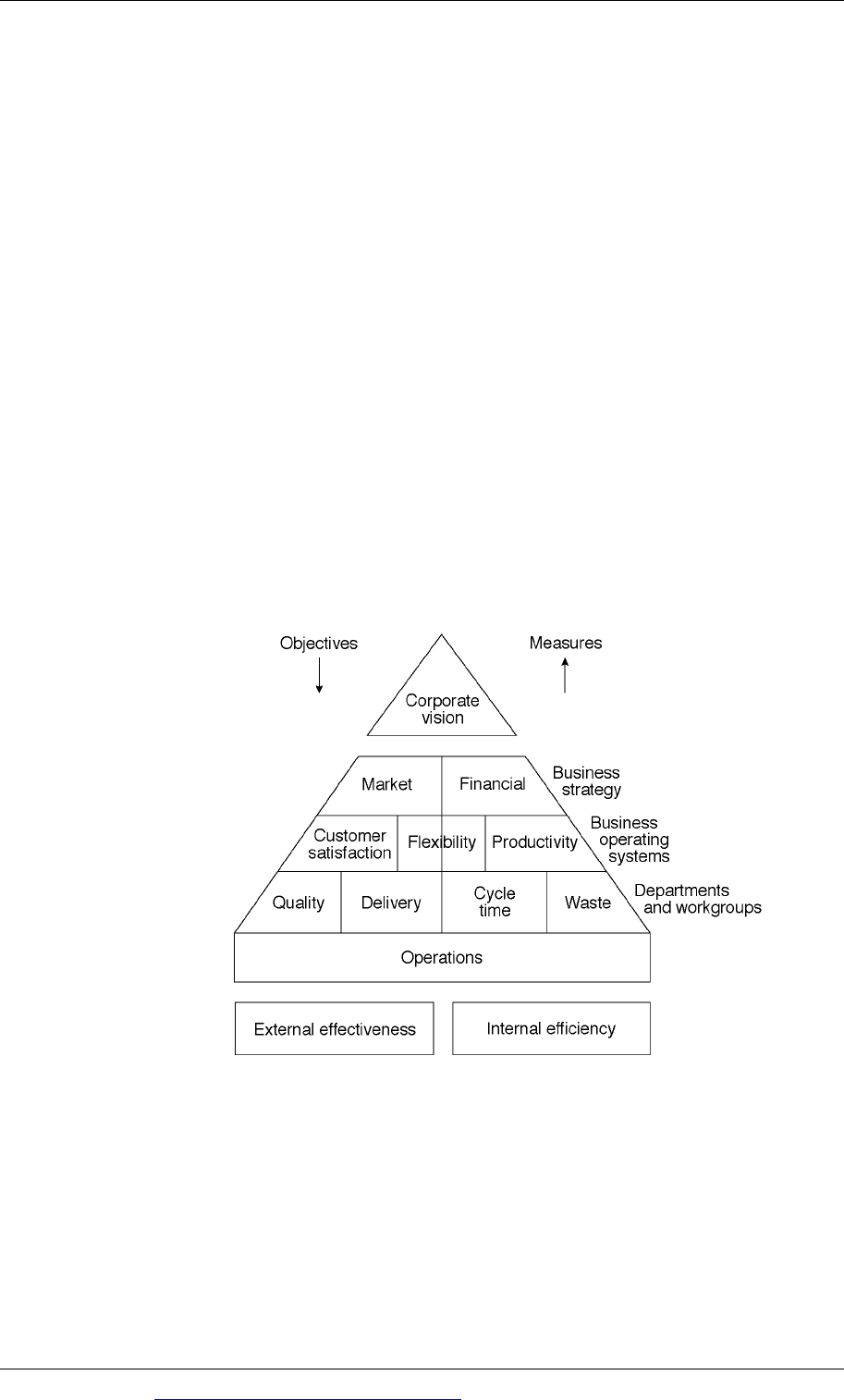ACCA F5 Performance Management - 2010 - Study text - Emile Woolf Publishing
Подождите немного. Документ загружается.


Chapter 12: The scope of performance measurement
© EWP Go to www.emilewoolfpublishing.com for Q/As, Notes & Study Guides 325
Variability in the circumstances of different businesses
With financial performance measurement, there are a limited number of financial
ratios that are used, which can be applied to all types of business.
With NFPIs, the key measures of performance vary between different types of
business, and depend on the nature of the business. For example, the key non-
financial measures of performance for a chemical manufacturer will differ from
those of a passenger transport company such as a bus or train company.
Time scale for achievement
Financial performance targets are often set for a budget period, and actual
performance is compared against budget. Non-financial performance targets need
not be restricted to one year, and in some cases it may be sensible to establish targets
for a longer term (or possibly a shorter term) than one year.
Unfortunately, if some employees are awarded cash bonuses for achieving non-
financial performance targets, there will be a tendency to set annual targets in order
to fit in with the annual budget cycle.
Setting targets for quality
The quality of a product or service may be a key aspect of non-financial
performance. However, it can be very difficult to define what is meant by ‘quality’.
For example, quality could refer to:
Features of a product design or aspects of a service
The number of mistakes that are made in a process
The number of rejected items in quality inspection
Value for money.
There are different aspects of quality, but for the purpose of performance
measurement it is necessary to identify which are the critical or key aspects of
quality, and set quality performance targets accordingly.
3.2 Analysing NFPIs
You need to remember the guidance from the F5 examiner about measuring and
assessing performance. The same guidance applies to non-financial performance as
to financial performance.
It is not sufficient simply to calculate a performance ratio or other performance
measurement.
You need to explain the significance of the ratio – What does it mean? Does it
indicate good or bad performance, and why?
Look at the background information given in the exam question and try to
identify a possible cause or reason for the good or bad performance.
Possibly, think of a suggestion for improving performance. What might be done
by management to make performance better?

Paper F5: Performance management
326 Go to www.emilewoolfpublishing.com for Q/As, Notes & Study Guides © EWP
3.3 NFPIs in service industries
Management accounting has its origins in manufacturing and construction
industries. Over time, service industries have become a much more significant
aspect of business, especially in countries with developed economies.
Performance measures – both financial and non-financial – are needed for service
industries, but the key measures that are best suited to service industries are often
very different from the key NFPIs in manufacturing.
Even some of the key financial performance measures in service industries may be a
combination of both financial and non-financial performance, such as:
Annual sales revenue per cubic metre of shelf space (ratio used by supermarkets
and other stores)
Cost per tonne-mile carried (road haulage companies)
Cost per passenger-mile carried (transport companies)
Average income per consultant day (management consultancy company).

Chapter 12: The scope of performance measurement
© EWP Go to www.emilewoolfpublishing.com for Q/As, Notes & Study Guides 327
The balanced scorecard approach
The concept of the balanced scorecard
The balanced scorecard: four perspectives of performance
Using the balanced scorecard
Conflicting targets for the four perspectives
4 The balanced scorecard approach
4.1 The concept of the balanced scorecard
The balanced scorecard approach was developed by Kaplan and Norton in the
1990s as an approach to measuring performance in relation to long-term objectives.
They argued that for a business entity, the most important objective is a financial
objective. However, in order to achieve financial objectives over the long term, it is
also necessary to achieve goals or targets that are non-financial in nature, as well as
financial.
The concept of the balanced scorecard is that there are several aspects of
performance (‘perspectives on performance’) and targets should be set for each of
them. The different #perspectives’ may sometimes appear to be in conflict with each
other, because achieving an objective for one aspect of performance could mean
having to make a compromise with other aspects of performance. The aim should
be to achieve a satisfactory balance between the targets for each of the different
perspectives on performance. These targets, taken together, provide a balanced
scorecard, and actual performance should be measured against all the targets in the
scorecard.
The reason for having a balanced scorecard is that by setting targets for several key
factors, and making compromises between the conflicting demands of each factor,
managers will take a more balanced and long-term view about what they should be
trying to achieve. A balanced scorecard approach should remove the emphasis on
financial targets and short-term results.
However, although a balanced scorecard approach takes a longer-term view of
performance, it is possible to set shorter-term targets for each item on the scorecard.
In this way it is possible to combine a balanced scorecard approach to measuring
performance with the annual budget cycle, and any annual incentive scheme that
the entity may operate.
4.2 The balanced scorecard: four perspectives of performance
In a balanced scorecard, critical success factors are identified for four aspects of
performance, or four ‘perspectives’:
customer perspective
internal perspective

Paper F5: Performance management
328 Go to www.emilewoolfpublishing.com for Q/As, Notes & Study Guides © EWP
innovation and learning perspective
financial perspective.
Of these four perspectives, three are non-financial in nature.
For each perspective, Kaplan and Norton argued that an entity should identify key
performance measures and key performance targets. The four perspectives provide
a framework for identifying what those measures should be, although the specific
measures used by each entity will vary according to the nature of the entity’s
business.
For each perspective, the key performance measures should be identified by
answering a key question. The answer to the question indicates what are the most
important issues. Having identified the key issues, performance measures can then
be selected, and targets set for each of them.
Perspective The key question
Customer
perspective
What do customers value?
By recognising what customers value most, the entity can focus
its performance targets on satisfying the customer more
effectively. Targets might be developed for several aspects of
performance such as cost (value for money), quality or place of
delivery.
Internal
perspective
To achieve its financial and customer objectives, what processes
must the organisation perform with excellence?
Management should identify the key aspects of operational
performance and seek to achieve or maintain excellence in this
area. For example, an entity may consider that customers value
the quality of its service, and that a key aspect of providing a
quality service is the effectiveness of its operational controls in
preventing errors from happening.
Innovation
and learning
perspective
How can the organisation continue to improve and create value?
The focus here is on the ability of the organisation to maintain its
competitive position, through the skills and knowledge of its
work force and through developing new products and services, or
making use of new technology as it develops.
Financial
perspective
How does the organisation create value for its owners?
Financial measures of performance in a balanced scorecard
system might include share price growth, profitability and return
on investment.
Several measures of performance may be selected for each perspective, or just one.
Using a large number of different measures for each perspective adds to the
complexity of the performance measurement system.

Chapter 12: The scope of performance measurement
© EWP Go to www.emilewoolfpublishing.com for Q/As, Notes & Study Guides 329
4.3 Using the balanced scorecard
With the balanced scorecard approach the focus should be on strategic objectives
and the critical success factors necessary for achieving them. The main focus is on
what needs to be done now to ensure continued success in the future.
The main performance report for management each month is a balanced scorecard
report, not budgetary control reports and variance reports.
Examples of measures of performance for each of the four perspectives are as
follows. This list is illustrative only, and entities may use different measurements.:
Perspective Outcome measures
Critical financial
measures
Return on investment
Profitability and profitability growth
Revenue growth
Productivity and cost control
Cash flow and adequate liquidity
Avoiding financial risk: limits to borrowing
Critical customer
measures
Market share and market share growth
Customer profitability: profit targets for each
category of customer
Attracting new customers: number of new customers
or percentage of total annual revenue obtained from
new customers during the year
Retaining existing customers
Customer satisfaction, although measurements of
customer satisfaction may be difficult to obtain
On-time delivery for customer orders
Critical internal measures
Success rate in winning contract orders
Effectiveness of operational controls, measured by
the number of control failures identified during the
period
Production cycle time/throughput time
Amount of re-working of defective units
Critical innovation and
learning measures
Revenue per employee
Employee productivity
Employee satisfaction
Employee retention or turnover rates
Percentage of total revenue earned from sales of new
products
Time to develop new products from design to
completion of development and introduction to the
market

Paper F5: Performance management
330 Go to www.emilewoolfpublishing.com for Q/As, Notes & Study Guides © EWP
Example: balanced scorecard
Kaplan and Norton described the example of Mobil in the early 1990s, in their book
The Strategy-focussed Organisation. Mobil, a major supplier of petrol, was competing
with other suppliers on the basis of price and the location of petrol stations. Its
strategic focus was on cost reduction and productivity, but its return on capital was
low.
The company’s management re-assessed their strategy, with the aim of increasing
market share and obtaining stronger brand recognition of the Mobil brand name.
They decided that the company needed to attract high-spending customers who
would buy other goods from the petrol station stores, in addition to petrol.
As its high-level financial objective, the company set a target of increasing return on
capital employed from its current level of about 6% to 12% within three years.
From a financial perspective, it identified such key success factors as
productivity and sales growth. Targets were set for productivity (reducing
operating costs per gallon of petrol sold) and ‘asset intensity’ (ratio of
operational cash flow to assets employed).
From a customer perspective, Mobil carried out market research into who its
customers were and what factors influenced their buying decisions. Targets
were set for providing petrol to customers in a way that would satisfy the
customer and differentiate Mobil’s products from rival petrol suppliers. Key
issues were found to be having petrol stations that were clean and safe, and
offering a good quality branded product and a trusted brand. Targets were set
for cleanliness and safety, speedy service at petrol stations, helpful customer
service and rewarding customer loyalty.
From an internal perspective, Mobil set targets for improving the delivery of its
products and services to customers, and making sure that customers could
always buy the petrol and other products that they wanted, whenever they
visited a Mobil station.
4.4 Conflicting targets for the four perspectives
A criticism that has been made against the balanced scorecard approach is that the
targets for each of the four perspectives might often conflict with each other. When
this happens, there might be disagreement about what the priorities should be.
This problem should not be serious, however, if it is remembered that the financial
is the most important of the four perspectives for a commercial business entity. The
term ‘balanced’ scorecard indicates that some compromises have to be made
between the different perspectives.
A useful sporting analogy was provided in an article in
Financial Management
magazine (Gering and Mntambo, November 2001). They compared the balanced
scorecard to the judgements of a football team manager during a football match. The
objective is to win the match and the key performance measure is the score.

Chapter 12: The scope of performance measurement
© EWP Go to www.emilewoolfpublishing.com for Q/As, Notes & Study Guides 331
However, as the match progresses, the manager will look at other important aspects
of performance, such as the number of shots at the goal by each side, the number of
corner kicks, the number of tackles and the percentage of possession of the ball
enjoyed by the team.
Shots on goal corner kicks, tackles and possession of the ball are all necessary factors
in scoring goals, not conceding goals, and winning the match. The manager will
therefore use them as indicators of how well or badly the match is progressing.
However, the score is ultimately the only thing that matters.
In the same way, targets for four perspectives are useful in helping management to
judge progress towards the company’s objectives, but ultimately, success in
achieving those objectives is measured in financial terms. The financial objective is
the most important.

Paper F5: Performance management
332 Go to www.emilewoolfpublishing.com for Q/As, Notes & Study Guides © EWP
The performance pyramid
The concept of te performance pyramid
The pyramid structure: linking performance targets throughout an
organisation
Interpreting the performance pyramid
5 The performance pyramid
5.1 The concept of the performance pyramid
The performance pyramid is another approach to creating a structure for a
performance measurement system that combines non-financial and financial
performance indicators, and which helps to identify key areas of non-financial
performance.
The concept of a performance pyramid is based on the idea that an entity operates at
different levels and these levels form a hierarchy. The overall objective is at the top
of this hierarchy. Each level has different concerns and different performance
targets are appropriate for each level. However, performance objectives at a lower
level should support the performance objectives at a higher level. Taken together all
the performance objectives taken together support the overall objective of the
business as a whole.
Performance can therefore be seen as a pyramid structure, with a large number of
operational performance targets supporting higher-level targets, leading to targets
for the achievement of overall corporate objectives at the top.
5.2 The pyramid structure: linking performance targets throughout an
organisation
The performance pyramid model was developed by Lynch and Cross (1991. They
argued that traditional performance measurement systems were not as effective as
they should be, because they had a narrow financial focus – concentrating on
measures such as return on capital employed, profitability, cash flow and so on.
They argued that in a dynamic business environment, achieving strategic business
objectives depends on good performance with regard to non-financial aspects of
performance, and in particular:
Customer satisfaction. This is a ‘marketing’ objective: here, the focus is on
external/market effectiveness
Flexibility. The flexibility objective relates to both external effectiveness and
internal efficiency with in the organisation: an entity needs to respond to
developments and changes in circumstances when they occur.
Productivity: resource utilisation. Here, the focus is on internal efficiency, much
of which can be measured by financial performance and financial ratios or
variances)

Chapter 12: The scope of performance measurement
© EWP Go to www.emilewoolfpublishing.com for Q/As, Notes & Study Guides 333
These key ‘driving forces’ can be monitored at the operational level with
performance measures relating to:
quality
delivery
cycle time (e.g. the length of the production cycle, or the length of the customer
order handling cycle) and
waste.
Lynch and Cross argued that within an organisation, there are different levels of
management and each has its own focus. However, there must be consistency
between performance measurement at each management level, so that performance
measures at the operational level support the corporate strategy.
They presented these ideas in the form of a pyramid of targets and performance that
links operations to corporate strategy.
A performance pyramid can be presented as follows:
Performance pyramid
5.3 Interpreting the performance pyramid
The performance pyramid links strategic objectives with operational targets,
internally-focused objectives with externally-focused objectives, and financial and
non-financial objectives.
Objectives and targets are set from the top level (corporate vision) down to the
operational level. Performance is measured from an operational level upwards.
If performance targets are achieved at the operational level, targets should be

Paper F5: Performance management
334 Go to www.emilewoolfpublishing.com for Q/As, Notes & Study Guides © EWP
achieved at the operating systems level. Achieving targets for operating systems
should help to ensure the achievement of marketing and financial strategy
objectives, which in turn should enable the organisation to achieve its corporate
objectives.
A key level of performance measurement is at the operating systems level –
achieving targets for customer satisfaction, flexibility and productivity. To
achieve performance targets at this level, operational targets must be achieved -
for quality, delivery, cycle time and waste.
With the exception of flexibility, which has both an internal and an external
aspect, performance measures within the pyramid (and below the corporate
vision level) can be divided between:
- market measures, or measures of external effectiveness, and
- financial measures, or measures of internal efficiency.
The measures of performance are inter-related, both at the same level within the
pyramid and vertically, between different levels in the pyramid. For example:
- New product development is a business operating system. When a new
product is introduced to the market, success depends on meeting customer
needs (customer satisfaction), adapting customer attitudes and production
systems in order to make the changes (flexibility) and delivering the product
to the customer at the lowest cost for the required quality (productivity).
- Achieving improvements in productivity depends on reducing the cycle time
(from order to delivery) or reducing waste.
Lynch and Cross argued that the performance measures that are chosen should link
operations to strategic goals.
All operational departments need to be aware of how they are contributing to
the achievement of strategic goals.
Performance measures should be a combination of financial and non-financial
measures that are of practical value to managers. Reliable information about
performance should be readily available to managers whenever it is needed.
